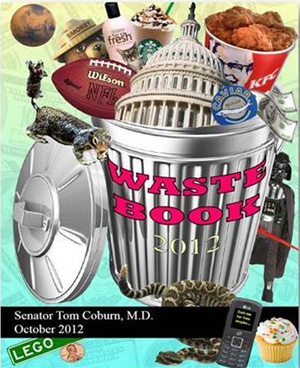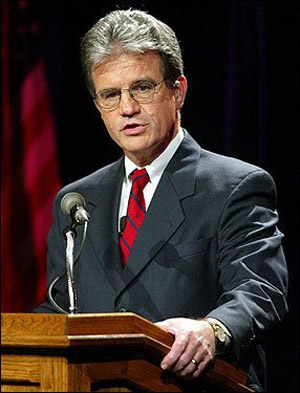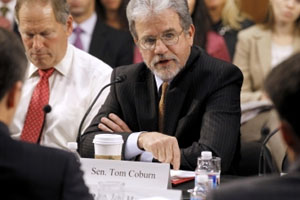 A leaked email from an Agriculture Department field officer adds fuel to claims President Obama’s political strategy is to make the billions in recent federal budget cuts as painful as possible to win the public opinion battle against Republicans.
A leaked email from an Agriculture Department field officer adds fuel to claims President Obama’s political strategy is to make the billions in recent federal budget cuts as painful as possible to win the public opinion battle against Republicans.
The email, circulated around Capitol Hill, was sent Monday by Charles Brown, a director at the agency’s Animal and Plant Health Inspection Service office in Raleigh, N.C. He appears to tell his regional team about a response to his recent question on the amount of latitude he has in making cuts.
According to the partially redacted email, the response came from the Agriculture Department’s budget office and in part states: “However you manage that reduction, you need to make sure you are not contradicting what we said the impact would be.”
The response noted that the administration had already told Congress that the APHIS would “eliminate assistance to producers in 24 states in managing wildlife damage to the aquaculture industry” without additional funds.
Arkansas Republican Rep. Tim Griffin said the administration’s response to Brown’s email shows a bid to undermine efforts to replace the cuts, known as sequester, with less onerous ones.
“This email confirms what many Americans have suspected: The Obama administration is doing everything they can to make sure their worst predictions come true and to maximize the pain of the sequester cuts for political gain,” Griffin said in a statement.
To read more from FOX News, click here.
 Not to put too fine a point on the issue; Senator Tom Coburn has published multiple books on government waste that could be cut immediately without reducing critical government services.
Not to put too fine a point on the issue; Senator Tom Coburn has published multiple books on government waste that could be cut immediately without reducing critical government services.
Dr. Coburn has also written several letters to officials on the issue of waste and today released the following letter to OMB Acting Director Jeffrey Zients, calling on OMB to put pressure on agencies to follow their guidance to increase scrutiny of all hiring activity in order to avoid furloughs of mission-critical positions.
In spite of OMB’s guidance, on March 4, 2013, the first business day after sequestration, there were 606 new federal jobs posted on usajobs.com and other outlets for federal work opportunities.
These included, among others:
• FDA advertised for “social media management service to streamline management of multiple social media platforms.”
• 23 openings related to recreation. Titles included Recreation Aid, Recreation Specialist, and Recreation Assistant
• The Air Force is looking to hire several full time painters with salaries of $40,000 to $46,000 while also searching to pay $143,600 to $165,300 for a Director of History and Museum Policies and Programs
• 4 openings for “Public Affairs Specialists” looking to pay a salary from $47,000 to $116,000
According to OMB, the average annual salary for a government employee is around $76,000, meaning that the average new hire equates to a one week furlough for 52 current government employees.
This is the seventh letter Dr. Coburn has sent to the administration and the second to OMB regarding hiring. For more information on past letters click here.
 Text of the letter follows:
Text of the letter follows:
March 5, 2013
Jeffrey Zients
Acting Director
White House Office of Management and Budget
Executive Office Building
725 17th Street, NW
Washington, DC 20503
Dear Director Zients,
In a February 25, 2013, letter to the Office of Management and Budget (OMB), I described many nonessential federal positions that the government was trying to fill, in spite of dire financial warnings about the impact of sequestration. On February 27, OMB issued memorandum M-13-05, which gave guidance to agencies regarding sequestration, including increased scrutiny of all hiring activity. This guidance is a step in the right direction and agencies should heed OMB’s advice.
A bleak picture has been painted of the effect of sequestration on the daily lives of taxpayers. According to these dire predictions, the public is being subjected to longer security lines, unsafe food, and a plethora of other perils due to this 2.3% cut to federal spending, even though the government will still spend more money this year than last. There are many ways that these agencies, if they make smart budget decisions, can deal with sequestration without affecting their mission.
 Despite OMB’s guidance, on Monday, March 4, 2013, the first business day after sequestration, there were 606 new federal jobs posted on usajobs.com.
Despite OMB’s guidance, on Monday, March 4, 2013, the first business day after sequestration, there were 606 new federal jobs posted on usajobs.com.
While some of these positions may be essential to the mission of the agency, others plainly are not. In addition to these jobs posted after sequestration went into effect, there are many vacancies for federal jobs that are still available and closing after March 4. According to OMB, the average annual salary for a government employee is around $76,000. This means that the average new hire equates to a one week furlough for 52 current government employees. If these nonessential positions are not filled, it would provide resources to avoid furloughs for some mission-critical positions.
• On March 4, FDA posted a solicitation for a “social media management service to streamline management of multiple social media platforms.”
• There are 23 openings for taxpayer-funded jobs with the title Recreation Aid, Recreation Specialist, or Recreation Assistant. At least three were posted March 4.
• The Air Force posted several full time openings March 4 for painters with a salary of $40,000-$46,000.
• The Air Force is also hiring a Director of History and Museums Policies and Programs at a salary of $143,600-$165,300 per year.
• There is a March 4 posting that described “few vacancies” open for law librarians at the Department of Justice with a salary of up to $115,742.
• There are 4 openings for “Public Affairs Specialists” with salaries from $47,000-$116,000.
• The Federal Energy Regulatory Commission is hiring a historian at a salary of ($42,209-$67,114 per year.
• The USDA is hiring a librarian at a salary of $74,872-$97,333.
While the Air Force may need leadership for its museums and history programs, and the USDA may need to keep its literature in order, those needs should take a back seat to the dire threat to public health and safety that some have claimed will result from sequestration.
Canceling the opening for the librarian position at USDA could offset one week of furloughs for as many as 104 to 156 food inspectors (based on an annual salary estimate of $31,000-$50,000).
 While these examples are illustrative, it will be up to each agency to determine whether it is more critical to fill any of the five thousand federal vacancies currently advertised than it is to avoid furloughing current employees. Freezing hiring of nonessential positions and solicitations for unnecessary services, such as the FDA social media contract, would save resources that could be applied to prevent furloughs of mission-critical employees.
While these examples are illustrative, it will be up to each agency to determine whether it is more critical to fill any of the five thousand federal vacancies currently advertised than it is to avoid furloughing current employees. Freezing hiring of nonessential positions and solicitations for unnecessary services, such as the FDA social media contract, would save resources that could be applied to prevent furloughs of mission-critical employees.
Sincerely,
Tom A. Coburn, M.D.
Ranking Member
